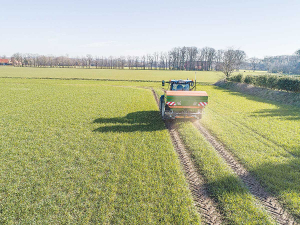Amazone unveils flagship spreader
With the price of fertiliser still significantly higher than 2024, there is an increased onus on ensuring its spread accurately at the correct rate.
 Accurate, tailored fertiliser application plays a critical role in reducing costs and protecting the environment.
Accurate, tailored fertiliser application plays a critical role in reducing costs and protecting the environment.
Cultivation, seeding and fertiliser application specialist Amazone claims its new AutoTS spreading system can increase yields along the borders of the paddock by up to 17%.
Accurate, tailored fertiliser application plays a critical role in reducing costs and protecting the environment.
The proven disc-integrated system uses shortened blades for more accurate, flexible spreading along borders, allowing settings to be adjusted to a specific spreading situation, such as a crop edge, boundary or water course, from the tractor cab.
CLAAS Harvest Centre product specialist - Amazone, Steve Gorman, says "for example, if a paddock borders onto land with a similar crop, 100 per cent of the application rate can be spread right up to the edge of the field using the side spreading function. If the paddock borders a road or public footpath, the boundary spreading function reduces the maximum throwing distance and prevents fertiliser from being thrown across the border."
Large-scale field trials conducted over several years have compared the performance of AutoTS system to conventional border spreading techniques under real-time, practical conditions.
Comparing calcium ammonium nitrate being spread at 24 metres, over three separate passes, the average yield of the five-metre border treated using a conventional border spreading system was only 68% of the main body of the paddock. This increased to 85% when using the Amazone AutoTs system.
Gorman says this improvement can really add up in small or irregular-shaped fields because they have a higher proportion of border area.
The value generated by the AutoTS system, compared to conventional border spreading systems, can be estimated using an Amazone's online calculator at www.amazone.net/border-spreading-calculator.
The Push-Up Challenge, an event which combines mental health and fitness, is set to launch in New Zealand in 2026.
Last month's Agritechnica event led to a wide group of manufacturers celebrating successes when the 2026 Tractor of the Year Competition winners, selected by a panel of European journalists, were announced in Hanover Germany.
According to the latest Federated Farmers banking survey, farmers are more satisfied with their bank and less under pressure, however, the sector is well short of confidence levels seen last decade.
Farmer confidence has taken a slight dip according to the final Rabobank rural confidence survey for the year.
Former Agriculture Minister and Otaki farmer Nathan Guy has been appointed New Zealand’s Special Agricultural Trade Envoy (SATE).
Alliance Group has commissioned a new heat pump system at its Mataura processing plant in Southland.
President Donald Trump’s decision to impose tariffs on imports into the US is doing good things for global trade, according…
Seen a giant cheese roll rolling along Southland’s roads?